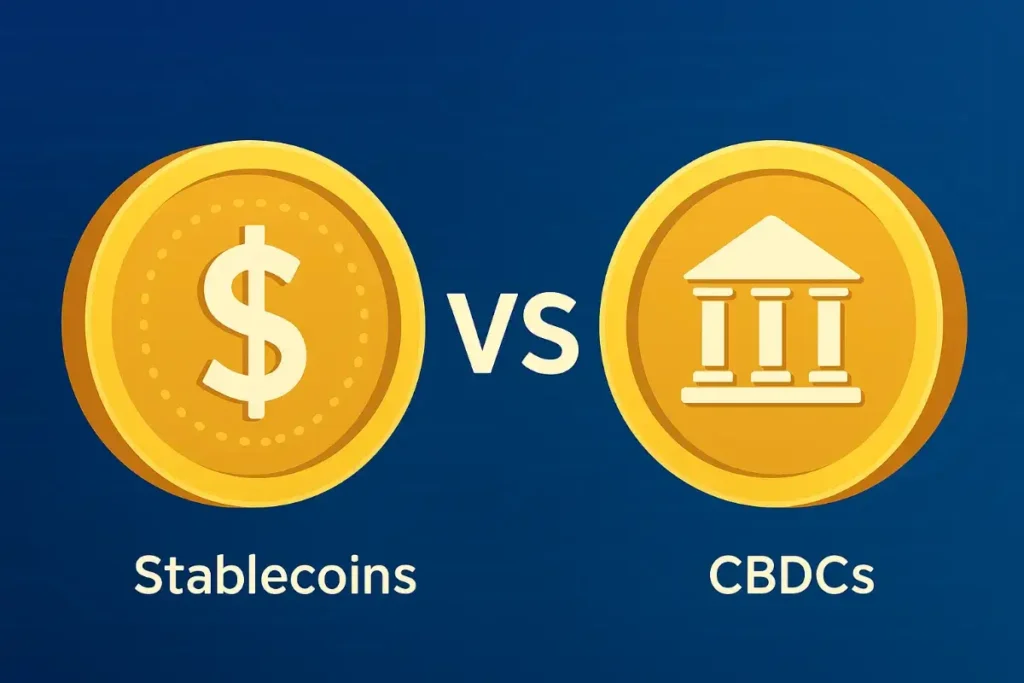Introduction: The Digital Currency Battle in 2025
The year 2025 will be remembered as the year where digital money evolved. Once again, central bank digital currencies (CBDCs) and stablecoins are now the focus of all conversations within global financial debate. Both promise fast, secure and borderless transactions, yet they envision very different futures on the one hand, from the other.
The debate between CBDCs and Stablecoins is, in fact, touching on technology for the sake of it. It will surely touch on factors such as control, trust, privacy, and financial inclusion. All governments, banks, tech companies, and everyday users are keenly interested in how these two forms of digital currency impact the next chapter of global finance.
Understanding CBDCs
Digital representations of a nation’s official currency that are issued and overseen by the central bank are known as CBDCs. They maintain the same value as physical cash but exist entirely in digital form.
Key features include:
- State-backed or sovereign equivalent value to fiat currency
- Regulated by a central bank
- Domestic payment systems integration
CBDCs will modernize the currency and payment system and make it highly efficient, with as little reliance as possible on cash.
Understanding Stablecoins
Stablecoins are private digital currencies that are entirely backed by a stable asset, usually a fiat currency like the US dollar or a commodity like gold. Their objective is to reduce the level of price volatility while leveraging the advantage of blockchain technology with fast transactions and full transparency.
Common types include:
- Fiat-backed stablecoins (for example, USDC, USDT)
- Crypto-collateralized stablecoins (for example, DAI)
- Algorithmic stablecoins (maintain stability via code-based supply adjustments)
Why CBDCs and Stablecoins Dominate 2025 Discussions
Push for cashless societies, growth of decentralized finance (DeFi), and the need for faster cross-border payments make the fact that CBDCs vs Stablecoins are the center stage of global finance.
CBDCs are seen by central banks as the means to control the digital age where they go head to head with private innovators, who support stablecoins as a step toward open, borderless money. Both have been growing at impressive rates making their rivalry unavoidable.
Key Similarities Between CBDCs vs Stablecoins
Despite the differences in nature, it proves that CBDC and stablecoin distinct attributes still share some essential traits:
- Both operate digitally and aim for quick settlement.
- Both try to lower transaction cost compared to traditional banks.
- Both can be integrated with blockchain-based financial systems.
Major Differences Between CBDCs vs Stablecoins
| Aspect | CBDCs | Stablecoins |
|---|---|---|
| Issuer | Central bank | Private companies or decentralized protocols |
| Backing | National fiat currency | Commodities, cryptocurrency assets |
| Regulation | Strict, government-controlled | Varies; often regulated as private assets |
| Privacy | Limited, due to government oversight | Higher, but depends on design |
| Adoption Driver | Public policy and national infrastructure | Market demand and blockchain adoption |
Advantages of CBDCs
- CIatural stability backed up by government’s guarantees
- Connections within national frameworks that allow for smooth payments
- Potential to eliminate financial crime through tracked transactions
- More direct and controlled management of the money supply to support monetary policy
Advantages of Stablecoins
- Universality in accessibility, free of country borders
- Bridging DeFi lending, staking, and yield farming
- Reducing obstacles to entrance for individuals and small enterprises
- Innovation-friendly due to private sector development
Risks and Challenges Facing Both
CBDCs:
- Privacy concerns regarding government surveillance
- Possibility of negative interest rate policies
- Risk of excluding the unbanked if not designed inclusively
Stablecoins:
- Risk of depegging if reserves are mismanaged
- Regulatory uncertainty in many countries
- Exposed to hacks related to blockchain
Use Cases in 2025
CBDCs are increasingly used for:
- The increased domestic payments and government benefits deliveries is where CBDCs are growing.
- Cross-border settlements between custodial central banks.
- Cost reductions associated with cash handling costs.
Stablecoins are thriving in:
- Pervasive in DeFi for lending and trading.
- E-commerce and cross-border retail payments.
- Emerging economies are also covered for remittances.
Regulatory Perspectives
The entire regulatory schemes globally are being set up for CBDCs vs Stablecoins.
- Most of the central banks are already running pilots for CBDC, such as China’s digital yuan and the European Union’s digital euro.
- On the part of stablecoins, reserve transparency sustains scrutiny alongside consumer protection issues.
A few jurisdictions including Singapore and Switzerland have embraced the middle-of-the-road frameworks allowing both to coexist under clear rules.
Global Adoption Trends

In 2025:
- Sophisticated CBDC testing is currently being conducted on over 60% of these central banks.
- For now, stablecoins got the bulk of the action going in DeFi and crypto trading with daily transaction volumes in the billions.
- Stablecoins are seen by the developing world as the bridges on which to move toward financial inclusion, while the more developed economies are now pushing CBDCs for more policy control.
Expert Opinions and Predictions
Economists predict that CBDC will enter the official institutions of the finance world, with the stablecoin mostly drawing on peer-to-peer and decentralized finance.
Some experts predict a kind of hybrid model – using central bank digital currencies built on public blockchain infrastructure, while private companies build stablecoinlike interfaces for users.
The Future: Can CBDCs and Stablecoins Coexist?
While competition is intense, coexistence is possible. CBDCs could handle large-scale, regulated transactions, while stablecoins serve niche, decentralized, and cross-border markets. The end user who benefits from quicker, less expensive, and more inclusive payment choices will ultimately be the true winner.
Final Thoughts
With the emerging trends of cash vs coins, technological rivalry becomes ideological as well. The stability provided by government control defines the former; the latter promises much more innovation through competition in the private sector.
Most likely, though, both will step into the world of finance together, creating a better connected and more efficient global economy.
FAQs
A1: CBDCs, or Central Bank Digital Currencies, are digital versions of a country’s fiat currency that the central bank issues and regulates.
A2: Stablecoins are cryptocurrencies pegged to a stable asset, such as the US dollar, to minimize price volatility. They are typically issued by private companies rather than governments.
A3: Governments back and fully control CBDCs, while private companies issue stablecoins and run them on decentralized or hybrid blockchain systems.
A4: In 2025, countries like China, India, and the European Union are rolling out or expanding their CBDC programs, with the US exploring a digital dollar pilot.
A5: Yes, stablecoins face tighter regulations in 2025, especially in the US, UK, and EU, to ensure transparency, reserve backing, and compliance with anti-money laundering laws.
A6: Both offer near-instant settlement, but CBDCs may have an advantage in domestic transactions due to integration with national banking systems.
A7: The competition could reshape payment systems, increase financial inclusion, and influence how governments and private firms control digital money.
A8: Stablecoins offer stability and liquidity rather than high returns. People mainly use them for trading, remittances, and hedging against volatility, not for long-term investment.

